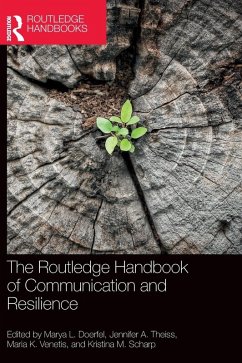The Routledge Handbook of Communication and Resilience
Herausgeber: Doerfel, Marya L.; Venetis, Maria K.; Theiss, Jennifer A.
The Routledge Handbook of Communication and Resilience
Herausgeber: Doerfel, Marya L.; Venetis, Maria K.; Theiss, Jennifer A.
- Gebundenes Buch
- Merkliste
- Auf die Merkliste
- Bewerten Bewerten
- Teilen
- Produkt teilen
- Produkterinnerung
- Produkterinnerung
This handbook provides a wide-ranging resource for theory building, empirical investigations, and practical applications. It is a useful resource for scholars and advanced students in communication studies, social psychology, sociology, human development, public policy, and family sciences.
Andere Kunden interessierten sich auch für
![The Routledge Handbook of Ethics in Technical and Professional Communication The Routledge Handbook of Ethics in Technical and Professional Communication]() The Routledge Handbook of Ethics in Technical and Professional Communication279,99 €
The Routledge Handbook of Ethics in Technical and Professional Communication279,99 €![Routledge Handbook of Applied Communication Research Routledge Handbook of Applied Communication Research]() Routledge Handbook of Applied Communication Research344,99 €
Routledge Handbook of Applied Communication Research344,99 €![Creative Resilience and COVID-19 Creative Resilience and COVID-19]() Creative Resilience and COVID-19167,99 €
Creative Resilience and COVID-19167,99 €![The Handbook of International Trends in Environmental Communication The Handbook of International Trends in Environmental Communication]() The Handbook of International Trends in Environmental Communication259,99 €
The Handbook of International Trends in Environmental Communication259,99 €![The Handbook of Communication Science and Biology The Handbook of Communication Science and Biology]() The Handbook of Communication Science and Biology258,99 €
The Handbook of Communication Science and Biology258,99 €![The Handbook of Communication History The Handbook of Communication History]() The Handbook of Communication History390,99 €
The Handbook of Communication History390,99 €![The Routledge Reader in Rhetorical Criticism The Routledge Reader in Rhetorical Criticism]() The Routledge Reader in Rhetorical Criticism266,99 €
The Routledge Reader in Rhetorical Criticism266,99 €-
-
-
This handbook provides a wide-ranging resource for theory building, empirical investigations, and practical applications. It is a useful resource for scholars and advanced students in communication studies, social psychology, sociology, human development, public policy, and family sciences.
Produktdetails
- Produktdetails
- Verlag: Routledge
- Seitenzahl: 578
- Erscheinungstermin: 24. September 2025
- Englisch
- Abmessung: 260mm x 183mm x 35mm
- Gewicht: 1268g
- ISBN-13: 9781032801537
- ISBN-10: 1032801530
- Artikelnr.: 73873299
- Herstellerkennzeichnung
- Libri GmbH
- Europaallee 1
- 36244 Bad Hersfeld
- gpsr@libri.de
- Verlag: Routledge
- Seitenzahl: 578
- Erscheinungstermin: 24. September 2025
- Englisch
- Abmessung: 260mm x 183mm x 35mm
- Gewicht: 1268g
- ISBN-13: 9781032801537
- ISBN-10: 1032801530
- Artikelnr.: 73873299
- Herstellerkennzeichnung
- Libri GmbH
- Europaallee 1
- 36244 Bad Hersfeld
- gpsr@libri.de
Marya L. Doerfel is a Professor of Communication at Rutgers University, USA. She researches how multi-level organizational communication constitutes resilience. Funded by the National Science Foundation and recognized with numerous awards, publications include her book, Organizing Inclusion: Moving diversity from demographics to communication processes and journal articles published in outlets such as Journal of Communication , Public Relations Review, and Nonprofit and Voluntary Sector Quarterly. Jennifer A. Theiss is a Professor of Communication at Rutgers University, USA. She studies the ways that interpersonal communication shapes and reflects relational turbulence during times of transition in close relationships and families and the ways that people can be resilient to such turmoil. Her scholarship has been recognized with more than a dozen major research awards for distinguished articles and career achievements. She is a Research Fellow for the International Association for Relationship Research, and the recipient of the Bernard J. Brommel Award for Distinguished Achievement in Family Communication Research from the National Communication Association. Maria K. Venetis is a Professor of Communication at Rutgers University, USA. She examines interpersonal processes among dyads managing critical health issues. As a co-author of the Dyadic Communicative Resilience Scale, her work centers dyadic resilience processes among patients and interdependent loved ones who manage severe illness such as cancer. She also examines communication processes among patients and companions with clinicians during healthcare interactions. Her scholarship is frequently published in outlets including Patient Education and Counseling and Health Communication. Kristina M. Scharp is an Associate Professor of Communication at Rutgers University, USA. She explores the process of marginalization and the ways people cope with the major disruptions to their lives. She has produced over 100 publications in outlets such as the Journal of Communication, Communication Research, Communication Monographs, and Human Communication Research. Her program of research has also been recognized with awards such as the International Communication Association's Early Career Award and a variety of Distinguished Article Awards from different divisions of the National Communication Association.
PART I: FOUNDATIONS OF COMMUNICATION AND RESILIENCE 1. Resilience as a
Multi-Layered Communication Process 2. Resilience, Power, and Privilege 3.
Conceptualizations, Types, Dimensions, and Factors Shaping Resilience
Triggers 4. Operationalizing, Observing, and Studying Resilience PART II:
INTERPERSONAL COMMUNICATION AND RESILIENCE 5. Interpersonal Resilience
Processes Across Contexts and Populations 6. Cultivating Resilience in
Close Relationships 7. Communication and Resilience in LGBTQ+ Relationships
8. Negotiating Resilience in Response to Hardship in Close Relationships 9.
Communication and Resilience in Families 10. A Lifespan Perspective on
Communication and Resilience 11. Communication and Resilience in Military
Couples 12. Burnout and Resilience Among Health Caregivers 13. Resilience
Communication in Medical Interactions PART III: ORGANIZATIONAL
COMMUNICATION AND RESILIENCE 14. High Resilience Organizations and
Communication 15. Leadership and Resilient Organizing 16. Career Resilience
in a Dynamic Workforce 17. Communication Resources and Work Team Resilience
18. Information Communication Technologies and Communicating Resilience
Among Organizations 19. Building Institutional and Community Resilience
Through Disaster Preparedness 20. Resilience in Lifesaving Critical Teams
21. Crisis, Organizational Renewal, and Resilience 22. Resilience and
Communication in the Aftermath of Sexual Harassment 23. A Trauma-Informed
Approach to Theorizing Resilience 24. Engaging Marginalized Communities in
Interorganizational Relationships PART IV: CULTIVATING RESILIENT
COMMUNITIES AND SOCIETIES 25. A Multiplex and Multilevel Approach to
Networked Community Resilience 26. Health and Human Service Network
Resilience 27. A Systems Approach to Building Resilient Information
Ecosystems in Disaster-Prone Communities 28. Resilience through the Lens of
Technology Maintenance 29. Cross-Sector Communication Design for Community
Resilience 30. Building Resilience within Hard-to-Reach Communities 31.
Resilience in Marginalized, Stigmatized, and Disenfranchised Communities
32. Fostering Resilience within Black Women's Sistah Circles 33. Resilience
in Marginalized Communities Facing Health Disparities 34. Public Health
Communication in Promoting Resilience 35. Women's Health and Resilience in
the Global South 36. Resilience and Renewal Approaches to Disruptive Events
Multi-Layered Communication Process 2. Resilience, Power, and Privilege 3.
Conceptualizations, Types, Dimensions, and Factors Shaping Resilience
Triggers 4. Operationalizing, Observing, and Studying Resilience PART II:
INTERPERSONAL COMMUNICATION AND RESILIENCE 5. Interpersonal Resilience
Processes Across Contexts and Populations 6. Cultivating Resilience in
Close Relationships 7. Communication and Resilience in LGBTQ+ Relationships
8. Negotiating Resilience in Response to Hardship in Close Relationships 9.
Communication and Resilience in Families 10. A Lifespan Perspective on
Communication and Resilience 11. Communication and Resilience in Military
Couples 12. Burnout and Resilience Among Health Caregivers 13. Resilience
Communication in Medical Interactions PART III: ORGANIZATIONAL
COMMUNICATION AND RESILIENCE 14. High Resilience Organizations and
Communication 15. Leadership and Resilient Organizing 16. Career Resilience
in a Dynamic Workforce 17. Communication Resources and Work Team Resilience
18. Information Communication Technologies and Communicating Resilience
Among Organizations 19. Building Institutional and Community Resilience
Through Disaster Preparedness 20. Resilience in Lifesaving Critical Teams
21. Crisis, Organizational Renewal, and Resilience 22. Resilience and
Communication in the Aftermath of Sexual Harassment 23. A Trauma-Informed
Approach to Theorizing Resilience 24. Engaging Marginalized Communities in
Interorganizational Relationships PART IV: CULTIVATING RESILIENT
COMMUNITIES AND SOCIETIES 25. A Multiplex and Multilevel Approach to
Networked Community Resilience 26. Health and Human Service Network
Resilience 27. A Systems Approach to Building Resilient Information
Ecosystems in Disaster-Prone Communities 28. Resilience through the Lens of
Technology Maintenance 29. Cross-Sector Communication Design for Community
Resilience 30. Building Resilience within Hard-to-Reach Communities 31.
Resilience in Marginalized, Stigmatized, and Disenfranchised Communities
32. Fostering Resilience within Black Women's Sistah Circles 33. Resilience
in Marginalized Communities Facing Health Disparities 34. Public Health
Communication in Promoting Resilience 35. Women's Health and Resilience in
the Global South 36. Resilience and Renewal Approaches to Disruptive Events
PART I: FOUNDATIONS OF COMMUNICATION AND RESILIENCE 1. Resilience as a
Multi-Layered Communication Process 2. Resilience, Power, and Privilege 3.
Conceptualizations, Types, Dimensions, and Factors Shaping Resilience
Triggers 4. Operationalizing, Observing, and Studying Resilience PART II:
INTERPERSONAL COMMUNICATION AND RESILIENCE 5. Interpersonal Resilience
Processes Across Contexts and Populations 6. Cultivating Resilience in
Close Relationships 7. Communication and Resilience in LGBTQ+ Relationships
8. Negotiating Resilience in Response to Hardship in Close Relationships 9.
Communication and Resilience in Families 10. A Lifespan Perspective on
Communication and Resilience 11. Communication and Resilience in Military
Couples 12. Burnout and Resilience Among Health Caregivers 13. Resilience
Communication in Medical Interactions PART III: ORGANIZATIONAL
COMMUNICATION AND RESILIENCE 14. High Resilience Organizations and
Communication 15. Leadership and Resilient Organizing 16. Career Resilience
in a Dynamic Workforce 17. Communication Resources and Work Team Resilience
18. Information Communication Technologies and Communicating Resilience
Among Organizations 19. Building Institutional and Community Resilience
Through Disaster Preparedness 20. Resilience in Lifesaving Critical Teams
21. Crisis, Organizational Renewal, and Resilience 22. Resilience and
Communication in the Aftermath of Sexual Harassment 23. A Trauma-Informed
Approach to Theorizing Resilience 24. Engaging Marginalized Communities in
Interorganizational Relationships PART IV: CULTIVATING RESILIENT
COMMUNITIES AND SOCIETIES 25. A Multiplex and Multilevel Approach to
Networked Community Resilience 26. Health and Human Service Network
Resilience 27. A Systems Approach to Building Resilient Information
Ecosystems in Disaster-Prone Communities 28. Resilience through the Lens of
Technology Maintenance 29. Cross-Sector Communication Design for Community
Resilience 30. Building Resilience within Hard-to-Reach Communities 31.
Resilience in Marginalized, Stigmatized, and Disenfranchised Communities
32. Fostering Resilience within Black Women's Sistah Circles 33. Resilience
in Marginalized Communities Facing Health Disparities 34. Public Health
Communication in Promoting Resilience 35. Women's Health and Resilience in
the Global South 36. Resilience and Renewal Approaches to Disruptive Events
Multi-Layered Communication Process 2. Resilience, Power, and Privilege 3.
Conceptualizations, Types, Dimensions, and Factors Shaping Resilience
Triggers 4. Operationalizing, Observing, and Studying Resilience PART II:
INTERPERSONAL COMMUNICATION AND RESILIENCE 5. Interpersonal Resilience
Processes Across Contexts and Populations 6. Cultivating Resilience in
Close Relationships 7. Communication and Resilience in LGBTQ+ Relationships
8. Negotiating Resilience in Response to Hardship in Close Relationships 9.
Communication and Resilience in Families 10. A Lifespan Perspective on
Communication and Resilience 11. Communication and Resilience in Military
Couples 12. Burnout and Resilience Among Health Caregivers 13. Resilience
Communication in Medical Interactions PART III: ORGANIZATIONAL
COMMUNICATION AND RESILIENCE 14. High Resilience Organizations and
Communication 15. Leadership and Resilient Organizing 16. Career Resilience
in a Dynamic Workforce 17. Communication Resources and Work Team Resilience
18. Information Communication Technologies and Communicating Resilience
Among Organizations 19. Building Institutional and Community Resilience
Through Disaster Preparedness 20. Resilience in Lifesaving Critical Teams
21. Crisis, Organizational Renewal, and Resilience 22. Resilience and
Communication in the Aftermath of Sexual Harassment 23. A Trauma-Informed
Approach to Theorizing Resilience 24. Engaging Marginalized Communities in
Interorganizational Relationships PART IV: CULTIVATING RESILIENT
COMMUNITIES AND SOCIETIES 25. A Multiplex and Multilevel Approach to
Networked Community Resilience 26. Health and Human Service Network
Resilience 27. A Systems Approach to Building Resilient Information
Ecosystems in Disaster-Prone Communities 28. Resilience through the Lens of
Technology Maintenance 29. Cross-Sector Communication Design for Community
Resilience 30. Building Resilience within Hard-to-Reach Communities 31.
Resilience in Marginalized, Stigmatized, and Disenfranchised Communities
32. Fostering Resilience within Black Women's Sistah Circles 33. Resilience
in Marginalized Communities Facing Health Disparities 34. Public Health
Communication in Promoting Resilience 35. Women's Health and Resilience in
the Global South 36. Resilience and Renewal Approaches to Disruptive Events








